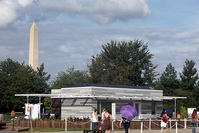Solar Decathlon move a loss for DC, Decathlon, and the US
Last week, the Department of Energy announced the Solar Decathlon would not be held in DC in 2013. The move is a big loss for city of Washington, the National Mall, the Decathlon itself, and even US climate policy.
The Solar Decathlon has been held in DC every time since its inception in 2002. In its first 4 iterations, it occupied a prominent place on the National Mall. Last year’s event faced a rockier road in its planning stages, eventually landing in West Potomac Park.
While DOE touted a move as an opportunity to “expand the excitement excitement generated by the competition and encourage participation from new communities,” it’s hard to think the 2011 planning troubles didn’t make the decision just a bit easier.
Last January, the Department of Energy announced the Decathlon would not take place on the Mall as it had the previous four times. Word was the Department of the Interior, home to the inimitable National Park Service, had pressured DOE because of the Decathlon’s negative impact on the Mall’s otherwise pristine greenery. NPS applauded the move.
Rumors later surfaced that the Decathlon would land at National Harbor, the bastion of sustainability located outside the Beltway, with dismal transit access and no incidental foot traffic.
After protests from competitors, fans and even Congress members, DOE finally settled on West Potomac Park, at least in central DC, though not terribly convenient or visible. As a result, the organizers had to provide a costly shuttle service from the closest metro stations. The permit conditions and the lack of large paths also required they lay down more tile flooring than ever before to protect the park’s grass.
Whatever the cause of the westward move, it will be real detriment to Washington, DC and to the vitality of our monumental core. The National Mall, which has been called a failed public space, suffers from a lack of nearby residences and non-museum attractions.
The two weeks of the Solar Decathlon is the only time you can find dwelling units other than the White House in the region’s most central, yet least populated Census tract. Since several team members have to live in their houses, the event literally doubles the population.
Most events on the mall last several hours or a day, attracting people for a very specific purpose only to cast them out again as soon as the event is over. People come for the event, not for the place.
The Solar Decathlon turned the National Mall into a destination, a true place with an interesting streetscape. While the hours to go in the houses were limited, people could admire the craftsmanship from outside any time of day. This encouraged lingering, what Jane Jacobs called one of the most important functions of a good public space.
The Decathlon’s placemaking ability was apparent this year, despite its less-than-optimal location. West Potomac Park, which is typically only visited by kickballers and 10k runners, felt lively for two weeks.
It was also a great opportunity for residents and visitors of the nation’s capital and fastest growing city to see the potential beauty in compact, energy-efficient living. I can attest to this.
During this year’s Decathlon, I was right in the middle of the first-time home buying experience. We were feeling the temptation of the “go farther, get more” mindset that fueled the inexorable creep of suburbia. Seeing small, but beautiful and impeccably designed entries emphasized to us what you can do very little space. We came away fascinated, and firmer in our resolve to forgo space in order to find a excellent urban location.
How did the Decathlon end up in Orange County? The City of Irvine and the Orange County Great Park fought for it.
Meanwhile, it’s unclear if NPS even submitted a bid. When asked, DOE said it couldn’t release a list of applicants or discuss specific bids. I contacted NPS last week to see if they or an associated group had submitted a bid for the Mall. They haven’t yet responded.
Of course, given the agency’s joy at this year’s move from the Mall, it’s doubtful they made much effort to keep it here.
Where other regions have entities that fight to bring vibrant events like the Solar Decathlon in, the Washington region does not. Residents here suffer because the Park Service, as a national entity, doesn’t actually represent their interests, though they are its most immediate stakeholders.
It’s only fair that the Department of Energy spread the love of the Solar Decathlon around the country. But the US loses the ability to truly showcase its commitment to sustainability. Building two dozen passive houses on America’s front lawn, blocks from the halls of power, sends a powerful message.
The Solar Decathlon certainly attracts visitors from afar on its own. But it also benefits immensely from being located in a place where there are hundreds of thousands of other travelers who would stop by given the easy opportunity.
Washington, DC is the nation’s capital and a huge, international tourist destination. Irvine, California, is a distant suburb of Los Angeles with 215,000 people. Not much of a showcase.
Even in West Potomac Park, with the Washington Monument peeking over the trees on one end, and the Jefferson Memorial rotunda on the other, it was still clear where you were.
Not any more. Moving the Decathlon around has some merit, but the new location is a true shame. Few think of sustainability when they think about Orange County.

